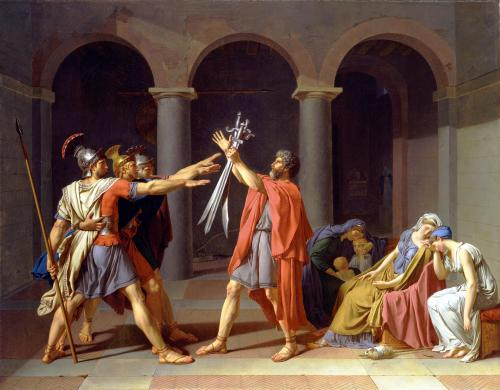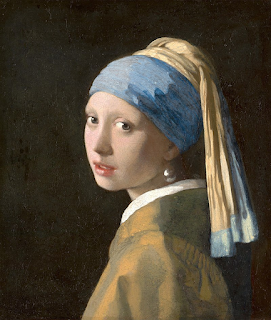Classical Art Analysis
Classical Analysis of Jacques-Louis David’s Oath of the Horatii, Thomas Jefferson’s Monticello, and Joseph Wright’s A Philosopher Lecturing on the Orrery
and How Scientific Advancements
Influenced Them
Neoclassical
art earned its name due to the fact that it takes many of its traits from the classical
art of the Romans and Greeks. This resurgence of Classical styles was in a
large part due to the recent discovery of the ruins of Pompeii and Herculaneum
by De Alcubierre in 1748 (Tronchin). Having
been covered in volcanic ash in 79 C.E., the city of Pompeii was preserved in
time and appeared very similar to how it did before its destruction. This was
an incredible find for the newly emerging art historian profession (Tronchin).
The bodies of those found at the site, along with their homes, greatly inspired
artists of the Neoclassical Period and brought with it a renewed passion for
ancient times. Depictions of Greek and Roman mythology once again began
dominating the world of art along with historical scenes. One such
portrayal is Jacques-Louis David’s Oath of the Horatii.
Oath of the
Horatii is a 130.2 by 166.7 cm oil painting on canvas. Created in 1785, the
painting was commissioned by King Louis XVI of France while David was serving
the king in Louvre, France. The painting was meant to illicit loyalty to
the state as the brothers are pledging to serve their empire (Oath). This is an
understandable sentiment to wish to inspire but it proved ineffective as the
French Revolution occurred just five years after the Oath of the Horatii’s
completion. As for technique and composition, Neoclassical work emphasized line
and structure allowing color to take a back seat importance-wise in regards to
the rest of the painting (Classicism). Artists valued harmony and a sense of
balance in their work. Additionally, idealized figures as seen in the art of
Pompeii once again became the standard as they had in antiquity (Classicism).
Neoclassical history paintings, such as Oath of the Horatii, had
additional criteria that the vast majority met. Illustrating prominent events
from religion, mythology, and literature, Oath of the Horatii and other
Neoclassical historical paintings like it were meant to evoke feelings of
loyalty and bravery while providing examples of great acts of heroism and other
virtuous behavior (Black McCoy, British). For these reasons, Neoclassical
history paintings were created in direct opposition to previous flamboyant art
styles. Oath of the Horatii brings forth feelings of duty
accompanied by great sadness, a sentiment many more would soon empathize with
as a result of the bloody and violent French Revolution that was fast approaching.
The influence of Pompeii’s excavation and the subsequent reemergence of
Classical styles made its way not only into paintings but also into the world's
architecture.
Monticello
is one of the best-known examples of Neoclassical architecture. Designed by
Thomas Jefferson as his personal home in Virginia, the construction of Monticello
began in 1769 (House). This first rendition was completed in 1784 but was later
redesigned from 1796 to 1809 (House).
One of the home's most distinguishing features is its massive
Classical-style columns at the entrance to the house. These columns became a
staple of the time, harkening back to the Pantheon and Parthenon of ancient
times. The vast majority of government buildings and others of importance were
created in the Neoclassical style, wishing to elicit feelings of significance
in those who saw them (LaChiusa). This re-emergence of Classical styles in
architecture was inspired by the unearthing of Pompeii as were many other
aspects of the period. Monticello is an impressive structure, meant to
bring forth ideals of grandeur and importance by emulating some of the ancient
time's best-known structures. For a man of Jefferson’s standing and position,
these are precisely the emotions one would want to conjure as such feelings
would reflect onto him. The use of the Neoclassical in government structures
was prevalent in many of the major cities across the world and is still evident
today (LaChiusa). This creates a sense of connection between important buildings
in Washington DC, Sydney, St Petersburg, and Shanghai (LaChiusa). Although the
discovery of Pompeii was revolutionary and infiltrated many aspects of the
Neoclassical Period from paintings, sculptures, architecture, and even music,
it was not the only scientific discovery of the 1700s which influenced the
era’s art.
The discovery of
physics, the creation of the first encyclopedia, the invention of the
microscope, and the confirmation of the Copernican theory of Earth moving
around the sun were some of the most influential advancements of the
era (Revolution). A Philosopher Lecturing on the
Orrery by Joseph Wright of Derby is a 4′ 10″ by 6′ 8″ oil painting on
Canvas created between 1763-65 (Fox). Wright likely created this painting
after witnessing a lecture by James Ferguson, an astronomer and instrument
maker, who demonstrated the use of an Orrery in addition to other scientific
instruments (Discovery). In the painting, a philosopher is lecturing to several
onlookers about the placement of the sun at the center of the universe and how
all other planets orbit around it. Had the man in the image chosen to teach the
Copernican Theory at an earlier time he would have encountered substantial
opposition from religious orders, as many had before him. However, with the
aforementioned scientific advancements came an age of enlightenment where
people became more concerned with discovering for themselves, through the newly
invented scientific method, how the world worked rather than blindly accepting
what the church taught (Fox).
A Philosopher Lecturing on the Orrery is an
excellent example of these shifting ideals in the world, brought on through
scientific advancement which pierced every aspect of life including the arts.
Although images of people teaching and discussing topics of advancement have
been around for centuries, A Philosopher Lecturing on the Orrery stands
apart as the embodiment of ideas that would have likely been suppressed or even
destroyed in previous eras. From its subdued colors, strong structure, and
proud depiction of scientific innovation for all to experience, A
Philosopher Lecturing on the Orrery is one of the best representations of
Neoclassical art including its style and values. A Philosopher
Lecturing on the Orrery perfectly encompasses the new and reemerging
scientific and social ideas of the Neoclassical period with the brilliant light
at the center of the painting illuminating the people to new ways of viewing
the world. Although it holds no claims of great fame, to me this painting is a
piece of profound hope, an image that exhibits the greatest aspects of the
Neoclassical Period.
Work Cited
“Art and
Scientific Discovery in the 1700s,” SATEMPLE, WordPress, October 15, 2013. https://satemple.wordpress.com/2013/10/15/art-and-scientific-discovery-in-the-1700s/.
Accessed 18, March 2023.
“British and
American History Paintings of the 1700s,” National Gallery of Art, https://www.nga.gov/features/slideshows/british-and-american-history-paintings-of-the-1700s.html.
Accessed 18, March 2023.
Black McCoy, Claire.
“Jacques-Louis David, Oath of the Horatii,” Smarthistory, https://smarthistory.org/jacques-louis-david-oath-of-the-horatii/.
Accessed 18, March 2023.
Fox, Abram. “Wright
of Derby, A Philosopher Lecturing on the Orrery,” Khan Academy, https://www.khanacademy.org/humanities/ap-art-history/later-europe-and-americas/enlightenment-revolution/a/wright-of-derby-a-philosopher-lecturing-on-the-orrery.
Accessed 18, March 2023.
A History of the
Scientific Revolution, 1500-1700,” Brewminate, August 20, 2020. https://brewminate.com/a-history-of-the-scientific-revolution-1500-1700/.
Accessed 18, March 2023.
“House FAQ,” Monticello,
https://www.monticello.org/house-gardens/the-house/house-faqs/.
Accessed 18, March 2023.
LaChiusa, Chuck. “The
Neoclassicising of Pompeii,” buffaloah, January 2018. https://buffaloah.com/a/virtual/italy/pomp/tc.html.
Accessed 18, March 2023.
“The Oath of the Horatii,” Toledo Museum of Art, http://emuseum.toledomuseum.org/objects/55069/the-oath-of-the-horatii?ctx=739d11b7-2f63-4ad0-9596-69dcd5791a3e&idx=0#:~:text=Label%20TextIn%201784%20Louis,pledging%20to%20fight%20the%20Curiatii.
Accessed 19, March 2023.
Tronchin, Francesca. “The rediscovery
of Pompeii and the other cities of Vesuvius,” Khan Academy, https://www.khanacademy.org/humanities/ancient-art-civilizations/roman/x7e914f5b:pompeii/a/the-rediscovery-of-pompeii-and-the-other-cities-of-vesuvius#:~:text=De%20Alcubierre%20shifted%20his%20focus,town's%20name%3A%20REI%20PUBLICAE%20POMPEIANORUM.
Accessed 19, March 2023.






Hi Abby, great post! Thank you for sharing these artworks. I enjoyed reading your interpretation of Jacques-Louis David’s Oath of the Horatii and I agree, it’s symbolism makes the piece breathtaking along with the artists ability to capture the classical style and the beautiful color scheme. I liked that you included architecture, I think architecture was such a unique way to capture art, especially in the 1800th century. Furthermore, architecture could also represent not only art but also support the scientific discovery. The last piece you chose, A Philosopher Lecturing on the Orrery by Joseph Wright, has become one of my favorite pieces to explore. I also chose this piece.
ReplyDelete